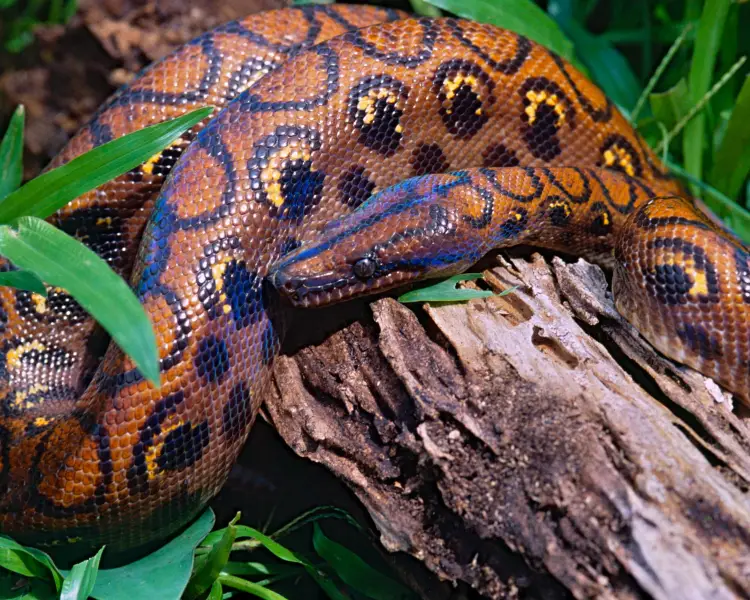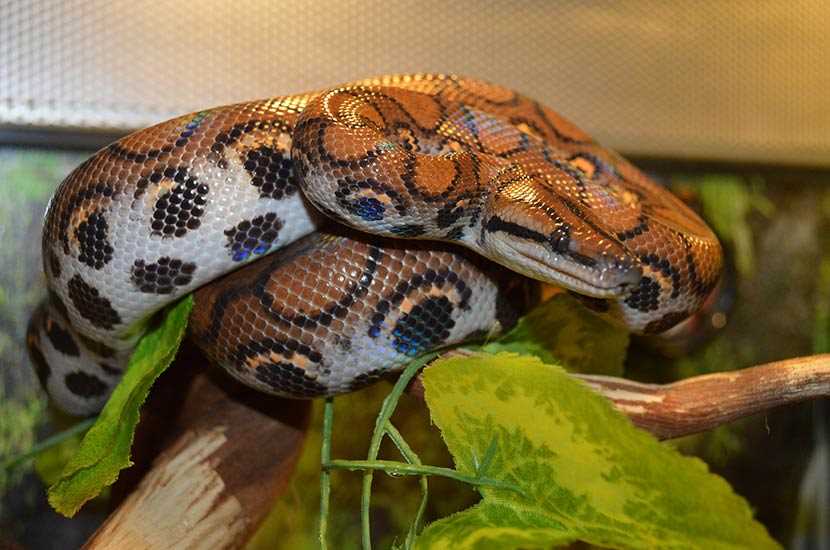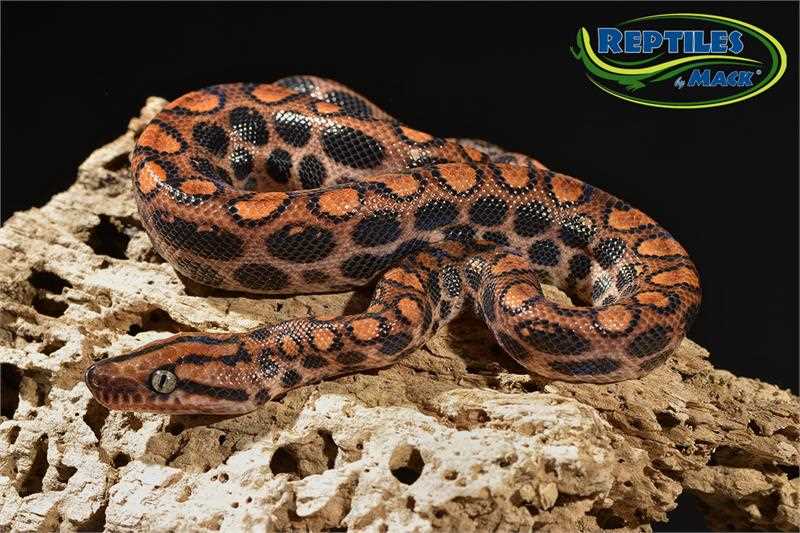
One of the most striking features of the Brazilian Boa is its iridescent scales, which give it a rainbow-like appearance. These vibrant colors, ranging from deep reds to brilliant greens and blues, make it a true marvel to behold. Additionally, this boa has a muscular body and a strong grip, allowing it to climb trees with ease and maneuver through its natural habitat of dense rainforests.
Brazilian Boa Care Guide
- Housing: Brazilian boas require a spacious enclosure to accommodate their size. A terrarium or glass tank with secure lids is ideal, providing enough space for the snake to move, climb, and burrow.
- Temperature and humidity: Maintaining the right temperature and humidity levels is crucial for the health and well-being of your Brazilian boa. The temperature should be kept between 80-85°F during the day and slightly cooler at night. The humidity level should be around 60-70% to replicate their natural habitat.
- Lighting: While Brazilian boas do not require UVB lighting like some other reptiles, it is still beneficial to provide a light source that mimics a natural day and night cycle. This can be achieved with a regular light bulb or a reptile-specific light.
- Breeding and reproduction: Breeding Brazilian boas can be a complex process and should only be attempted by experienced breeders. Proper care, temperature cycling, and providing a suitable breeding environment are essential for successful reproduction.
Following this care guide will help ensure that your Brazilian boa thrives in its captivity. Remember to do thorough research and consult reputable sources for additional information on caring for your Brazilian boa.
Brazilian Boa Characteristics
The Brazilian Boa is a large, heavy-bodied constrictor snake that can reach lengths of up to 10 feet or more. It has a muscular, elongated body with a distinct pattern of dark brown or black markings on a lighter background color. The snake’s head is elongated and slightly triangular in shape, with a prominent heat-sensing pit on each side. Its eyes are large and round, providing excellent daytime vision.
One of the most unique features of the Brazilian Boa is its ability to sense heat using special organs located on its face. This allows the snake to hunt and locate prey, even in complete darkness. The Brazilian Boa is an ambush predator, relying on stealth and surprise to capture its prey. It will constrict its prey using its strong body muscles, suffocating it before swallowing it whole.
The Brazilian Boa is a docile and relatively easy-to-care-for pet, making it a popular choice among snake owners. It requires a spacious enclosure with appropriate hiding spots and climbing opportunities. The snake’s diet consists mainly of small mammals, such as mice and rats, and it should be fed on a regular basis to maintain its health and well-being.
| Characteristic | Description |
|---|---|
| Size | The Brazilian Boa can reach lengths of up to 10 feet or more. |
| Appearance | It has a muscular, elongated body with dark brown or black markings on a lighter background color. |
| Special Features | The Brazilian Boa has heat-sensing pits on its face that allow it to locate prey even in darkness. |
| Temperament | It is a docile and relatively easy-to-care-for pet snake. |
| Diet | The Brazilian Boa mainly feeds on small mammals, such as mice and rats. |
Brazilian Boa Habitat

Additionally, the tank should be equipped with branches or vines for the snake to climb on, as Brazilian Boas are arboreal and enjoy spending time off the ground. These climbing structures will also provide enrichment and exercise for the snake.
| Temperature | Humidity |
|---|---|
Feeding a Brazilian Boa a varied diet of appropriately sized prey is essential to ensure its health and well-being. Juvenile Brazilian Boas can be fed on an appropriate-sized mouse or rat every 7-10 days, while adult snakes can be fed every 2-3 weeks with larger prey items such as rabbits or guinea pigs.
Brazilian Boa Diet
The Brazilian Boa is an exotic snake species native to South America. As a reptile, it belongs to the family of boas and is known for its stunning appearance and incredible strength. Many people find the Brazilian Boa to be an appealing pet due to its beautiful markings and manageable size.
Dietary Needs:
Prey Items:
The ideal prey items for a Brazilian Boa include mice, rats, and occasionally small birds. The size of the prey should be proportionate to the size of the snake’s head, ensuring that it can be swallowed without difficulty. It is crucial to never feed live prey to the snake, as this can result in injury or stress for both the snake and the prey.
Prey should be purchased frozen and thawed before feeding to the Brazilian Boa. This process can be done by placing the frozen prey in warm water for a few minutes or in the refrigerator overnight. Avoid using a microwave or boiling water, as this can cook the prey and cause it to lose nutritional value.
Feeding Schedule:
For juveniles, it is recommended to feed them every 4-7 days, while adults can be fed every 7-10 days. It is essential not to overfeed the Brazilian Boa, as obesity can lead to various health issues. Regularly monitor their body condition and adjust the feeding schedule accordingly.
Nutritional Supplements:
In some cases, it may be necessary to provide additional nutritional supplements to ensure that the Brazilian Boa receives all the essential nutrients. This is especially important when feeding prey that may have a lower nutritional value, such as those raised on commercial diets.
It is crucial to consult with a reptile veterinarian or experienced breeder to determine the specific nutritional needs of your Brazilian Boa and to develop an appropriate feeding plan.
Hydration:
Proper hydration is essential for the overall health and well-being of the Brazilian Boa. Provide a large water bowl in the enclosure to allow the snake to soak and drink as needed. Ensure that the water is clean and changed regularly to prevent bacterial growth.
Conclusion:
Feeding a Brazilian Boa a proper diet is crucial for its overall health and well-being. By offering a nutritionally balanced diet consisting of appropriately sized prey items, providing proper hydration, and consulting with a reptile expert, you can ensure that your exotic snake remains happy and healthy for years to come.
Tropical Boa Snake: Brazilian Boa Enclosure Setup

Creating the Perfect Enclosure
Creating the ideal enclosure for your Brazilian Boa is key to ensuring its well-being. By providing a habitat that mimics its natural environment, you can help your snake feel comfortable and secure.
Size: Brazilian Boas can grow up to 6-8 feet in length, so a spacious enclosure is essential. A minimum size of 4 feet long, 2 feet wide, and 2 feet high is recommended for an adult boa. Remember to provide enough space for the snake to stretch out and move around comfortably.
Substrate: Choose a substrate that retains moisture well, such as cypress mulch or coconut husk bedding. This helps maintain the necessary humidity levels in the enclosure.
Temperature and Humidity: Maintain a temperature gradient within the enclosure, with a warm side ranging from 85-90°F and a cooler side around 75-80°F. Use a thermostat to regulate the temperature and provide a heat source, such as an under-tank heating pad or ceramic heat emitter. The humidity level should be kept between 50-60% to replicate the tropical climate. Use a hygrometer to monitor and adjust humidity levels as needed.
Hide Boxes: Brazilian Boas are shy and like to have hiding spots where they can feel secure. Provide at least two hide boxes, one on the warm side and one on the cool side of the enclosure. You can use commercially available hide boxes or create your own using materials like cork bark or PVC pipes.
Decorations: Adding branches, vines, and artificial plants to the enclosure not only enhances the aesthetic appeal but also provides opportunities for the snake to climb and explore. Just make sure all decorations are securely anchored to prevent accidents or injuries.
Lighting: Brazilian Boas are primarily nocturnal, so they do not require UVB lighting. However, providing a low-level ambient light during the day can help establish a day-night cycle and maintain a natural circadian rhythm.
Cleaning and Maintenance: Regularly clean the enclosure by removing waste, refreshing the substrate, and sanitizing the hide boxes and decorations to prevent the buildup of harmful bacteria. Additionally, monitor the temperature and humidity levels daily to ensure they remain within the appropriate range.
By setting up an ideal enclosure for your Brazilian Boa, you are creating a safe and stimulating environment that promotes its physical and mental well-being. Remember to observe your snake’s behavior closely and make adjustments to the enclosure as necessary to ensure its continued health and happiness.
Brazilian Boa Temperature and Humidity Requirements
Temperature:
- The Brazilian Boa requires a temperature range of 75-85 degrees Fahrenheit (23-29 degrees Celsius) on the cool end of its enclosure.
- On the warm end, the temperature should be maintained between 85-90 degrees Fahrenheit (29-32 degrees Celsius).
- It is essential to provide a temperature gradient in the enclosure to allow the snake to thermoregulate. This can be achieved by using heat lamps, heat mats, or ceramic heaters.
Humidity:
- The Brazilian Boa requires a humidity level of 60-80% in its enclosure.
- To maintain the proper humidity, misting the enclosure with water once or twice a day is necessary.
- Using a substrate that retains moisture, such as coconut husk or cypress mulch, can also help maintain humidity levels.
Providing the Brazilian Boa with the appropriate temperature and humidity conditions will contribute to its overall health, digestion, and shedding process. It is crucial to create a comfortable and stress-free environment for this beautiful snake to thrive as a pet.
Brazilian Boa Handling and Interaction
Creating a Positive Environment
To establish a positive interaction with your Brazilian Boa, it is crucial to provide them with a suitable habitat that meets their physical and psychological needs. A comfortable and secure enclosure with proper temperature and humidity levels will contribute to their overall well-being and reduce stress.
Ensure that your snake has a sufficient number of places to hide and feel secure within the enclosure. This will give them a sense of security and allow them to retreat and relax when they desire.
Approaching and Handling Techniques
Support the snake’s body weight evenly, making sure to support the head and tail as well. This helps the snake feel secure and prevents any unnecessary strain. Always wash your hands before and after handling to maintain good hygiene, as some reptiles may carry bacteria or parasites.
Interaction Frequency
Regular interaction with your Brazilian Boa will help them become accustomed to handling and develop a trusting relationship with you. However, be cautious and observant of their behavior and body language while handling. If they show signs of discomfort or agitation, gently release and leave them to avoid any potential harm.
Conclusion
Brazilian Boa Health and Common Diseases
Common Diseases
1. Respiratory Infections: Brazilian Boas can develop respiratory infections if they are kept in an enclosure with inadequate humidity or if they are exposed to cold temperatures for prolonged periods. Symptoms of a respiratory infection may include wheezing, difficulty breathing, and excessive saliva.
2. Parasites: Brazilian Boas can become infested with parasites, such as mites or ticks. These parasites can cause irritation, skin problems, and even anemia in severe cases. Regular check-ups and proper cleaning of the enclosure can help prevent parasite infestations.
3. Stomach Issues: Brazilian Boas are prone to digestive problems, such as constipation or impaction, if they are fed inappropriate prey items or if their enclosure temperature and humidity levels are not kept within the correct range. Signs of stomach issues may include loss of appetite, regurgitation, and bloating.
Preventive Measures
1. Maintain Proper Husbandry: It is crucial to provide your Brazilian Boa with the appropriate temperature and humidity levels in its enclosure. Regularly monitor these factors to ensure they are within the recommended range for a healthy snake.
2. Quarantine New Snakes: If you introduce a new snake to your collection, it is essential to quarantine it for a period of time before adding it to your existing snakes. This will help prevent the spread of any potential diseases to your current pets.
3. Clean Enclosure Regularly: Regularly clean and disinfect your Brazilian Boa’s enclosure to reduce the risk of bacterial or fungal growth. Make sure to thoroughly clean any decor or substrate that may harbor parasites or pathogens.
Veterinary Care
If you notice any signs of illness or abnormal behavior in your Brazilian Boa, it is crucial to consult a reptile-experienced veterinarian as soon as possible. Reptile veterinarians have the knowledge and experience to diagnose and treat snake-related health issues effectively.
During a veterinary visit, the doctor may perform a physical examination, collect samples for laboratory testing, and provide appropriate treatment for the specific health concern. Regular check-ups are also recommended to ensure your Brazilian Boa’s overall well-being and early detection of any potential health problems.
Brazilian Boa Breeding and Reproduction
Reproduction Cycle
Like other snakes, Brazilian Boas reproduce through sexual reproduction. Breeding season for these snakes usually occurs in the spring or fall when the temperature and humidity levels are optimal. Males will often engage in courtship behavior, such as rubbing their scent glands on objects in their enclosure and performing mating dances to attract females.
Once a male and female pair, they will engage in copulation, which can last several hours. After mating, the female will go through a gestation period of approximately 120 to 150 days, depending on temperature and other environmental factors. During this time, she will develop eggs inside her body.
Egg Laying
When the female Brazilian Boa is ready to lay her eggs, she will seek out a suitable nesting spot. This can be a pre-made hide or box filled with damp substrate, such as sphagnum moss or cypress mulch. The dampness helps maintain an optimal level of humidity for the eggs.
The female will lay her eggs, which can range in number from 10 to 60, depending on her size and health. After laying the eggs, she will coil around them to provide protection and ensure proper incubation. Brazilian Boa eggs are leathery and have a soft shell, allowing the embryos to develop inside.
Incubation and Hatching
After the incubation period, the eggs will start to hatch. Hatchlings will emerge from the eggs and are often independent from the moment they hatch. It is crucial to provide a suitable enclosure with proper temperature, humidity, and feeding conditions for the newborn Brazilian Boas.
Brazilian Boa Frequently Asked Questions (FAQ)
Here are some commonly asked questions about Brazilian Boas:
- Q: What is a Brazilian Boa?
- Q: Are Brazilian Boas good pets?
- Q: What is the size of a Brazilian Boa?
- Q: What do Brazilian Boas eat?
- Q: What type of enclosure setup do Brazilian Boas need?
- Q: How should I handle and interact with a Brazilian Boa?
- Q: What are some common health issues in Brazilian Boas?
- Q: Can Brazilian Boas be bred in captivity?
A: Brazilian Boas can reach an average length of 4 to 6 feet, with females tending to be larger than males. In captivity, they can sometimes grow even larger with proper care and feeding.
A: Brazilian Boas require a spacious enclosure with appropriate temperature and humidity levels. A secure and well-ventilated terrarium with hiding spots, branches, and a water dish is essential for their well-being.
A: Some common health issues in Brazilian Boas include respiratory infections, mouth rot, parasites, and improper shedding. Regular vet check-ups, proper hygiene, and maintaining optimal conditions can help prevent these problems.
These are just a few commonly asked questions about Brazilian Boas. If you have any more inquiries or need further information, it’s recommended to consult with a reptile expert or veterinarian for personalized advice and guidance.

I’m Lena Adams—a product of an unconventional upbringing in the African wilderness. My father, a daring explorer of African wildlife, sparked my fascination with reptiles, a passion that intertwined with the tragic loss of my mother during an expedition, leaving an indelible mark on my life. Driven to understand the creatures that captivated my parents, I embarked on my journey, sharing insights about reptiles, frogs, and lizards on my website. Through my explorations and conservation efforts, I honour my family’s legacy while seeking connections—to the creatures, nature, and the mother whose presence I yearn to understand.
